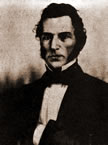Valentín Alsina
Valentín Alsina Ruano (born December 16, 1802 in Buenos Aires , † September 6, 1869 there ) was an Argentine lawyer and politician . He was governor of the independent state of Buenos Aires in 1852 and from 1858 to 1859 .
Life
Born in 1802, Valentín Alsina Ruano was the son of the Catalan Juan de Alsina Gaza and the Andalusian Maria Pastora Ruano y Gallen; he had a sister and a brother.
Alsina studied at the University of Cordoba under Gregorio Funes , the rector and his mentor, law . He worked as a lawyer and later became professor of law at the University of Buenos Aires .
Under the government of the first President of the United Provinces of the Río de la Plata , Bernardino Rivadavia (1826-1827), Alsina first appeared politically as Undersecretary of the Foreign Ministry. However, when he had to resign due to the rejection by most of the provinces, interim president Vicente López y Planes dissolved the constitution of 1826 and thus restored the autonomy of the provinces, Alsina became president of the judiciary instead. A central government controlled from Buenos Aires would not formally exist again in what was to become Argentina again 25 years later. As a result, the governor of Buenos Aires again took the most important position and represented the other provinces in foreign policy.
From 1828 Alsina was a member of the provisional government of Juan Galo de Lavalle and was not only appointed director of the library of Buenos Aires, later the national library , but also elected deputy to the legislature of Buenos Aires. Alsina was imprisoned under the dictatorship of Juan Manuel de Rosas . He managed to flee to the Uruguayan capital Montevideo , where he participated in the defense after the attack by the troops of de Rosas supporter General Manuel Oribe in 1843. After the defeat of the dictator de Rosas in the battle of Monte Caseros on February 3, 1852, Alsina returned to Buenos Aires and was appointed government minister of the province. The conflict between Buenos Aires and the Argentine Confederation, led by Justo José de Urquiza , soon brought Alsina back briefly to prison. Then he was banished. As a result, he drove a separatist revolution in Buenos Aires in September 1852 and was appointed governor of Buenos Aires on October 30th. Soon he had to resign because of the uprising of military colonels Hilario Lakes and Cayetano Laprida. He later returned to politics as a senator and shortly afterwards as foreign minister. After the Battle of Pavón in 1861, Valentín Alsina was elected to the Congress, which met in Buenos Aires. He then played a key role in the organization of the state and contributed to the drafting of the penal code, which was valid in Argentina well into the 20th century.
Valentín Alsina died on September 6, 1869 and was buried in the cemetery of Recoleta in the north of Buenos Aires .
In his role as President of the Chamber of Justice, Alsina was entrusted with the task of drafting the Código Rural , in which the rights of the rural population were regulated. He also wrote treatises, among other things, on the Argentine claim to the Falkland Islands ( El derecho de la República Argentina a las Islas Malvinas , Montevideo 1849) and on free navigation in the Río de la Plata .
Individual evidence
- ↑ a b c d e f g h Sandro Olaza Pallero: Valentín Alsina: jurista, político y publistica de la república provincial de Buenos Aires a la creación de una Nación. (PDF; 115 KB) Datos biográficos. In: uba.ar. Retrieved August 12, 2019 (Spanish).
- ^ Rolo: Valentín Alsina. In: findagrave.com . March 13, 2008, accessed August 12, 2019 .
- ^ Marcos Juan Belgrano Lagache: Valentín Alsina Ruano. Valentín Alsina. In: geneanet.org. Retrieved August 12, 2019 (Spanish).
- ↑ a b Biography of Valentín Alsina (1802-1869). In: thebiography.us. Retrieved August 12, 2019 .
| personal data | |
|---|---|
| SURNAME | Alsina, Valentín |
| ALTERNATIVE NAMES | Alsina Ruano, Valentín (full name) |
| BRIEF DESCRIPTION | Argentine lawyer and politician |
| DATE OF BIRTH | December 16, 1802 |
| PLACE OF BIRTH | Buenos Aires |
| DATE OF DEATH | September 6, 1869 |
| Place of death | Buenos Aires |
